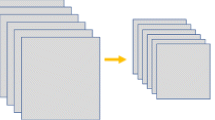Abstract
In this paper we propose using a novel differentiable convolutional distance transform layer for segmentation networks such as U-Net to regularize the training process. In contrast to related work, we do not need to learn the distance transform, but use an approximation, which can be achieved by means of the convolutional operation. Therefore, the distance transform is directly applicable without previous training and it is also differentiable to ensure the gradient flow during backpropagation. First, we present the derivation of the convolutional distance transform by Karam et al. [6]. Then we address the problem of numerical instability for large images by presenting a cascaded procedure with locally restricted convolutional distance transforms. Afterwards, we discuss the issue of non-binary segmentation outputs for the convolutional distance transform and present our solution attempt for the incorporation into deep segmentation networks. We then demonstrate the feasibility of our proposal in an ablation study on the publicly available SegTHOR data set.
Access this chapter
Tax calculation will be finalised at checkout
Purchases are for personal use only
Similar content being viewed by others
References
Bai, M., Urtasun, R.: Deep watershed transform for instance segmentation. In: Proceedings of the IEEE Conference on Computer Vision and Pattern Recognition, pp. 5221–5229 (2017)
Bui, T.D., Wang, L., Chen, J., Lin, W., Li, G., Shen, D.: Multi-task learning for neonatal brain segmentation using 3D dense-Unet with dense attention guided by geodesic distance. In: Wang, Q., et al. (eds.) DART/MIL3ID 2019. LNCS, vol. 11795, pp. 243–251. Springer, Cham (2019). https://doi.org/10.1007/978-3-030-33391-1_28
Cremers, D., Sochen, N., Schnörr, C.: Towards recognition-based variational segmentation using shape priors and dynamic labeling. In: Griffin, L.D., Lillholm, M. (eds.) Scale-Space 2003. LNCS, vol. 2695, pp. 388–400. Springer, Heidelberg (2003). https://doi.org/10.1007/3-540-44935-3_27
Dangi, S., Linte, C.A., Yaniv, Z.: A distance map regularized CNN for cardiac cine MR image segmentation. Med. Phys. 46(12), 5637–5651 (2019)
Girdhar, R., Fouhey, D.F., Rodriguez, M., Gupta, A.: Learning a predictable and generative vector representation for objects. In: Leibe, B., Matas, J., Sebe, N., Welling, M. (eds.) ECCV 2016. LNCS, vol. 9910, pp. 484–499. Springer, Cham (2016). https://doi.org/10.1007/978-3-319-46466-4_29
Karam, C., Sugimoto, K., Hirakawa, K.: Fast convolutional distance transform. IEEE Signal Process. Lett. 26(6), 853–857 (2019)
Ma, J., et al.: How distance transform maps boost segmentation CNNs: an empirical study. In: Medical Imaging with Deep Learning (2020)
Navarro, F., et al.: Shape-aware complementary-task learning for multi-organ segmentation. In: Suk, H.-I., Liu, M., Yan, P., Lian, C. (eds.) MLMI 2019. LNCS, vol. 11861, pp. 620–627. Springer, Cham (2019). https://doi.org/10.1007/978-3-030-32692-0_71
Oktay, O., Ferrante, E., et al.: Anatomically Constrained Neural Networks (ACNNs): application to cardiac image enhancement and segmentation. IEEE Trans. Med. Imaging 37(2), 384–395 (2018)
Paragios, N., Rousson, M., Ramesh, V.: Matching distance functions: a shape-to-area variational approach for global-to-local registration. In: Heyden, A., Sparr, G., Nielsen, M., Johansen, P. (eds.) ECCV 2002. LNCS, vol. 2351, pp. 775–789. Springer, Heidelberg (2002). https://doi.org/10.1007/3-540-47967-8_52
Pham, D.D., Dovletov, G., Warwas, S., Landgraeber, S., Jäger, M., Pauli, J.: Deep learning with anatomical priors: imitating enhanced autoencoders in latent space for improved pelvic bone segmentation in MRI. In: 2019 IEEE 16th International Symposium on Biomedical Imaging (ISBI 2019), pp. 1166–1169. IEEE (2019)
Ronneberger, O., Fischer, P., Brox, T.: U-net: convolutional networks for biomedical image segmentation. In: Navab, N., Hornegger, J., Wells, W.M., Frangi, A.F. (eds.) MICCAI 2015. LNCS, vol. 9351, pp. 234–241. Springer, Cham (2015). https://doi.org/10.1007/978-3-319-24574-4_28
Rousson, M., Paragios, N.: Shape priors for level set representations. In: Heyden, A., Sparr, G., Nielsen, M., Johansen, P. (eds.) ECCV 2002. LNCS, vol. 2351, pp. 78–92. Springer, Heidelberg (2002). https://doi.org/10.1007/3-540-47967-8_6
Trullo, R., Petitjean, C., Dubray, B., Ruan, S.: Multiorgan segmentation using distance-aware adversarial networks. J. Med. Imaging 6(1), 014001 (2019)
Author information
Authors and Affiliations
Corresponding author
Editor information
Editors and Affiliations
Rights and permissions
Copyright information
© 2021 Springer Nature Switzerland AG
About this paper
Cite this paper
Pham, D.D., Dovletov, G., Pauli, J. (2021). A Differentiable Convolutional Distance Transform Layer for Improved Image Segmentation. In: Akata, Z., Geiger, A., Sattler, T. (eds) Pattern Recognition. DAGM GCPR 2020. Lecture Notes in Computer Science(), vol 12544. Springer, Cham. https://doi.org/10.1007/978-3-030-71278-5_31
Download citation
DOI: https://doi.org/10.1007/978-3-030-71278-5_31
Published:
Publisher Name: Springer, Cham
Print ISBN: 978-3-030-71277-8
Online ISBN: 978-3-030-71278-5
eBook Packages: Computer ScienceComputer Science (R0)




